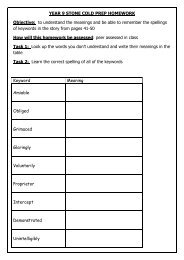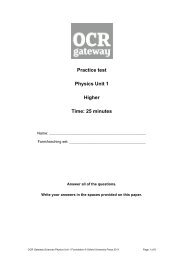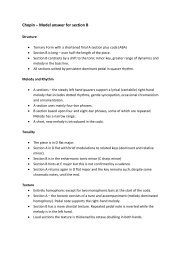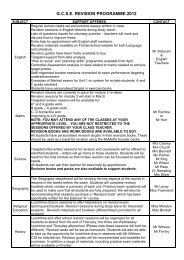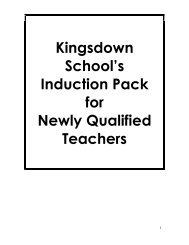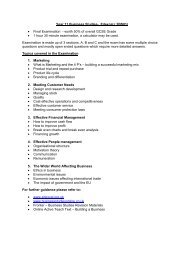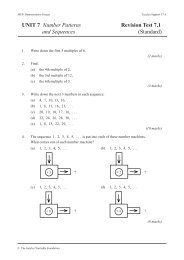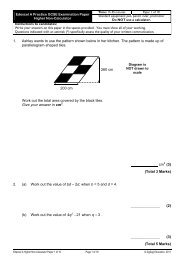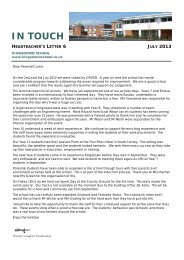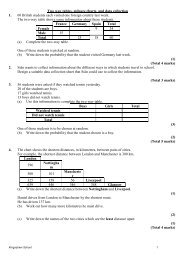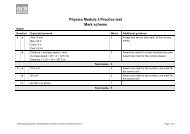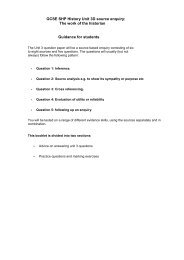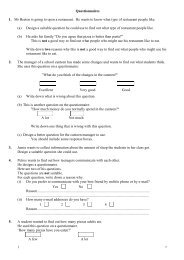Unseen Poetry
Unseen Poetry
Unseen Poetry
Create successful ePaper yourself
Turn your PDF publications into a flip-book with our unique Google optimized e-Paper software.
“Genuine poetry can communicate<br />
before it is understood”<br />
T.S.Eliot 1888-1965
<strong>Unseen</strong> <strong>Poetry</strong><br />
How to tackle the last part<br />
of the Literature<br />
Examination
What does “<strong>Unseen</strong>” mean?<br />
It will be a poem you have probably<br />
never seen before<br />
You are being tested on your ability<br />
to “read and respond” thoughtfully<br />
You are thinking about what the<br />
writer is trying to say<br />
Every word of the poem will count
The Question<br />
Write about the poem and its effect<br />
on you.<br />
You may wish to include some or all of these<br />
points:<br />
The poem’s content – what it is about<br />
The ideas the poet may have wanted us to think<br />
about<br />
The mood or atmosphere of a poem<br />
How it is written – words or phrases you find<br />
interesting, the way the poem is structured or<br />
organised<br />
Your response to the poem
Content<br />
What it’s about<br />
What happens in each section<br />
Is there an order or sequence?<br />
Who’s speaking?<br />
Story or idea?
Ideas<br />
What did the poet want us to think<br />
about?<br />
Is it a story<br />
or an idea<br />
or an expression of an emotion?<br />
Is there a message?
Mood and atmosphere<br />
What is the tone of the poem?<br />
How does it make you feel as you<br />
read it?<br />
Think about the 5 senses<br />
Think about the setting
How it is written<br />
Don’t just list or spot techniques<br />
Pick out words or phrases that you<br />
find effective and try to say why<br />
Think about the sound and rhythm of<br />
the poem. Does it have a beat? Or is<br />
it disjointed?<br />
Look at repetition of sounds or words
Imagery: a quick reminder<br />
<br />
<br />
An image in poetry (or in writing generally) is a<br />
picture in the reader’s mind created by the words<br />
used.<br />
Literal images can be effective ; “roses in snow”.<br />
The reader sees this in an uncomplicated way.<br />
Similes and metaphors are figurative images –<br />
they are built on comparison :<br />
SIMILE – “The pigeon bursts like a city”<br />
METAPHOR – “The sun died” - this is also an<br />
example of personification
How it is written 2<br />
Think about the structure or form<br />
Is it regular, uneven, awkward or<br />
easy to read. Does that tie in with<br />
the content?<br />
Look at the first line of each stanza<br />
to see how the meaning develops<br />
Look at the title and last line to give<br />
you a clue as to what the writer<br />
intended
Your Response<br />
It’s perfectly acceptable to say you find a<br />
poem confusing or misleading if you can<br />
explain why<br />
Try to be positive about some aspect of<br />
the poem or explain how you relate to an<br />
idea or event in it<br />
Uses phrases to show your sadness,<br />
surprise, enjoyment, anger, frustration,<br />
empathy……<br />
The examiner basically wants to know you<br />
have read and thought about this poem
Things you should NEVER write!<br />
At first I didn’t understand the poem but<br />
after reading it a couple of times I think…<br />
The poem has no rhythm<br />
I think the poem needed to rhyme more<br />
because I like poems that rhyme…<br />
I think the poet has done a very good job<br />
of writing this poem and they obviously<br />
thought carefully about it…
Ok – so let’s try an example<br />
It is absolutely essential to get into<br />
the habit of reading the poem at<br />
least twice before even trying to<br />
think of what you will write.<br />
Try to hear the poem aloud in your<br />
head – notice how it makes you feel<br />
and which words felt important as<br />
you read it.
He liked he said<br />
TRAMP<br />
By William Marshall<br />
rainbows and the sky<br />
and children who passed him in the<br />
street<br />
without staring.<br />
And he liked he said the<br />
ordinary things
like<br />
roses in snow<br />
and the way he<br />
remembered<br />
the first time<br />
the first time he<br />
really smelt the<br />
rain on<br />
a green hillside<br />
back home<br />
just before the sun died
And he liked he said<br />
thinking about<br />
who slept beneath the red<br />
brick roofs he<br />
walked by in the<br />
early part of the day<br />
from Land’s End to John O’Groats.<br />
but he said<br />
as a full time tramp with no<br />
other place to go he<br />
was worried<br />
where he would die -<br />
Land’s End or John O’Groats.
Start by annotating ….<br />
Tramp<br />
Any tramp –<br />
no name<br />
Like a child<br />
– a simple<br />
treat<br />
He liked he said<br />
rainbows and the sky<br />
and children who passed him in<br />
the<br />
street<br />
without staring.<br />
The speaker is<br />
someone reporting<br />
The tramp’s opinions<br />
Most children stare - likes the ones<br />
who don’t – why?
Using P-E-E<br />
Making sure you always use P-E-E<br />
statements in the poetry question<br />
will help you get a C<br />
Write two P-E-E statements about<br />
this poem now<br />
Point Evidence Explanation
How to get a C<br />
sustained response to situation/ideas<br />
or author's purposes<br />
effective use of details to support<br />
answer<br />
explanation of features of language<br />
interest<br />
explanation of effects<br />
achieved/authors' purposes
How to get a B<br />
qualified, developed response, exploring<br />
writers' ideas or methods<br />
details from poem linked to authors'<br />
intentions and purposes<br />
exploration of effects achieved/authors'<br />
purposes<br />
qualified/exploratory response to writers'<br />
ideas or methods
Check your response<br />
Have you explained?<br />
Have you used details?<br />
Is your writing on the poem<br />
sustained?<br />
Are you beginning to explore?<br />
Do you evaluate the writer’s<br />
techniques?
Improving your answer<br />
Go back and think about what you<br />
need to add to your notes to ensure<br />
you get a C or B
Remember:<br />
Read the poem carefully more than once<br />
Annotate the poem quickly<br />
You have 30 minutes<br />
Spend 5 mins reading the poem and<br />
annotating<br />
Think about the poem.
Writing your answer<br />
Use the bullet points provided to structure<br />
your answer<br />
Use P-E-E throughout<br />
Make at least two points for each bullet<br />
point – that’s 10 marks!<br />
Don’t panic if you don’t get it all – it is not<br />
a trick!
Practice makes perfect<br />
Practise annotating poems.<br />
Remember to annotate in different ways:<br />
questions, points, meanings, links,<br />
language techniques, poet’s ideas<br />
Thinking about the poems and questioning<br />
the ideas in them will help you be more<br />
confident in the exam.



